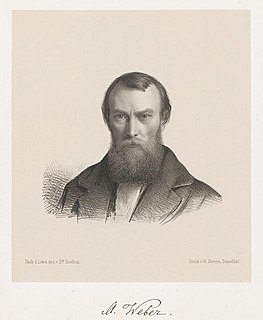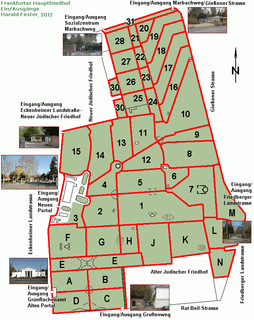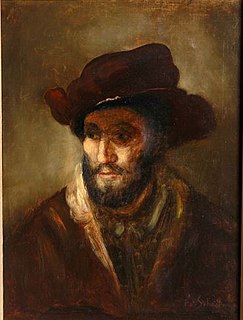
Karl Friedrich Lessing was a German historical and landscape painter, grandnephew of Gotthold Ephraim Lessing and one of the main exponents of the Düsseldorf school of painting.

Johann Baptist Wilhelm August Weber was a German painter; associated with the Düsseldorfer Malerschule.

Philipp Heinrich Moritz Alexander von Bethmann, born 8 October 1811 in Frankfurt am Main, died 2 December 1877 in Frankfurt am Main, was a German banker.
Eschenheimer Turm was a city gate, part of the late-medieval fortifications of Frankfurt am Main, and is a landmark of the city. The tower, which was erected at the beginning of the fifteenth century, is at once the oldest and most unaltered building in the largely reconstructed Frankfurter Neustadt, now better known as the Frankfurt-Innenstadt.
Karl Ludwig Reinhardt was a German classical philologist.

Jakob Heller was a German patrician, politician, and merchant. He was born and died in Frankfurt am Main, and served as Senior Bürgermeister of the Free City of Frankfurt in 1501 and 1513. Heller is best remembered today as a patron of the arts, as he commissioned the Heller Altarpiece from Albrecht Dürer and Matthias Grünewald, and a large sculpture of the crucifixion from Hans Backoffen.

Rudolf Burnitz was a German neo classical and early historicist architect. Burnitz was born in Ludwigsburg.
Susanna Maria Rebecca Elisabeth von Adlerflycht was a German painter known for her cartographic illustration of the Rhine Valley, the first in a genre of tourist maps known as Rheinpanorama.

Jakob Fürchtegott Dielmann was a German illustrator, genre and landscape painter. He was also one of the co-founders of the Artists' Colony at Kronberg.

The Frankfurt Main Cemetery is the largest cemetery in Frankfurt am Main, Germany. It was opened in 1828. The cemetery is located directly adjacent to two Jewish cemeteries—the Old Jewish Cemetery and the New Jewish Cemetery, Frankfurt —and together they form one of the largest cemetery areas in Germany. The cemetery is noted for its many monumental graves, its garden architecture and as the site of the graves of many notable individuals.

The Old Jewish Cemetery of Frankfurt is located at Rat-Beil-Straße directly adjacent to the oldest parts of the gentile Frankfurt Main Cemetery. Together, Frankfurt Main Cemetery, the Old Jewish Cemetery and the New Jewish Cemetery constitute one of the largest cemetery areas in Germany. The Old Jewish Cemetery is noted for many monumental graves and includes the graves of many notable individuals. The Old Jewish Cemetery is the largest of Frankfurt's twelve Jewish cemeteries.

Louise van Panhuys née von Barckhaus of Wiesenhütten was a German botanical artist and landscape painter.

The fortifications of Frankfurt were a system of military defences of the German city of Frankfurt am Main which existed from the Middle Ages into the 19th century. Around 1000 the first city wall was built. It enclosed the area of what is now the Königspfalz in modern Frankfurt. In the twelfth century the settlement expanded into what is now Altstadt. For its protection an additional wall, the Staufenmauer, was erected. Starting in 1333, the Neustadt suburb developed north of the Altstadt and was encompassed by an additional wall with five gates. In the fifteenth century, a "landwehr border" was created around the entire territory of the Free City of Frankfurt. Beginning in 1628, the medieval city wall was developed to form a bastion fortress under the municipal architect Johann Dilich.
Goethe Plaque of the City of Frankfurt is an award conferred by Frankfurt, Hesse, Germany and named after Johann Wolfgang von Goethe. The plaque was originally designed by sculptor Harold Winter. The plaque is awarded at irregular intervals to important poets, writers, artists, scientists and other personalities of the cultural life.

Friedrich Schaarschmidt was a German landscape painter and figure painter of the Düsseldorf school of painting, conservator and art writer.

Johann Jakob Jung was a German painter, specializing in religious subjects, and a member of the Nazarene movement.
Carl Wilhelm Ferdinand Guhr, also Karl Guhr was a German violinist, composer and from 1821 until his early death, theatre Kapellmeister and music entrepreneur in the Free City of Frankfurt.

Helene Adler was a German Jewish educator, writer, and poet.

Carl Balthasar Malß was a German poet, architect and theatre director.

Carl von Weinberg was an important Jewish German chemist, entrepreneur, patron of the arts and philanthropist.

















